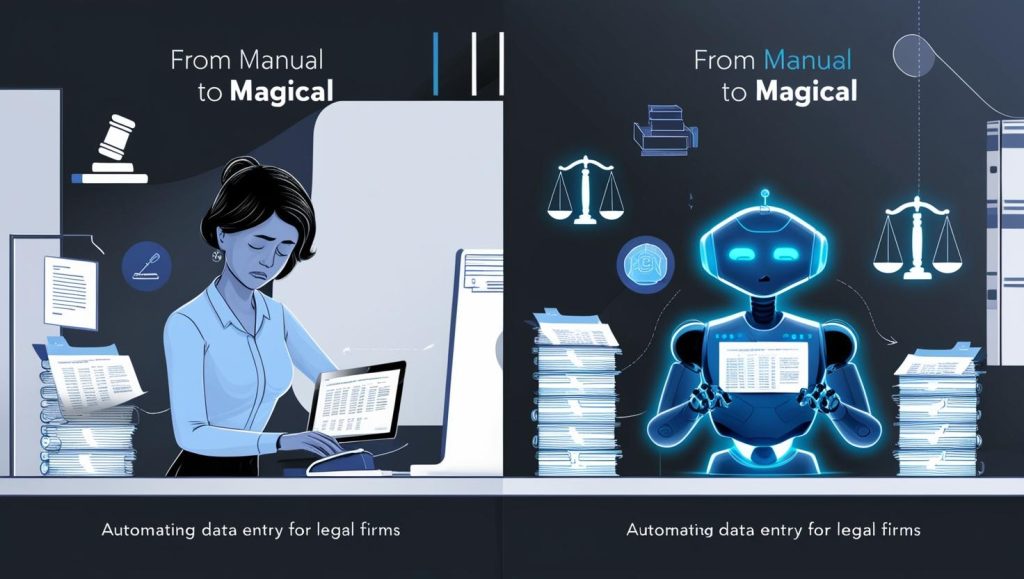From Manual to Magical: Automating Data Entry for Legal Firms
How RPA Frees Up Billable Hours and Improves Client Service

Introduction
Legal work is all about details—from case research and client onboarding to compliance and billing. When staff at a law firm spend hours on manual data entry, it detracts from their real, high-value focus: providing excellent legal counsel. The good news? Robotic Process Automation (RPA) can take over the administrative grind, letting legal professionals reclaim valuable time. Here’s how it works.
The Challenge: Endless Paperwork & Data Entry
Let’s imagine a mid-sized law firm, Dawson & Robbins LLP (anonymized). Handling corporate, real estate, and family law matters, they managed thousands of documents each month—client intake forms, court documents, billing statements, contracts, you name it. They had:
- Inefficient Onboarding: New client forms were scanned as PDFs, then manually typed into case management software.
- Repetitive Billing Tasks: Invoice details were re-entered from time-tracking software into an accounting program.
- Document Duplication: Paralegals spent hours duplicating data from discovery files, depositions, or legal briefs.
Pain Points:
- Time Sink: Staff lost up to 10 hours a week per person on data entry alone.
- Human Error: Typos and missed fields could lead to compliance risks.
- Delay in Client Service: Precious hours spent updating spreadsheets instead of progressing cases.
A Hypothetical RPA Solution
Looking to streamline, Dawson & Robbins engaged Ordron for an automation overhaul. While each law firm is unique, here’s a typical approach we might take:
- Identify Key Processes
- We start with a Data Health Check, assessing where manual entry occurs most frequently—client onboarding, invoicing, or updating compliance records.
- We determine which systems are in use: a case management platform, an accounting tool like QuickBooks, plus email and a shared file system.
- Design Automated Workflows
- OCR & Data Capture: RPA bots combine Optical Character Recognition (OCR) with script-based rules to extract text from scanned PDFs or emails.
- Verification Checks: The extracted data is automatically validated against a client database—if a client name is missing, the bot flags it.
- Data Entry into Systems: Once verified, the data is populated into the relevant fields in the firm’s case management software or accounting tool.
- Scheduled Automations
- We configure the bots to run at specific times—e.g., daily at 7 PM for newly scanned documents—or triggered by a paralegal dropping a file into a designated folder.
- Automated logs and email alerts notify the team if an entry fails or needs human approval.
An Example in Action: Automating Client Intake
When a new client signs on, they typically fill out a detailed intake form (digital or physical). Here’s how the RPA workflow might look:
- Form Submission
- The client or paralegal scans the signed form.
- The scanned PDF is saved in a “New Intakes” folder.
- Bot Retrieval & OCR
- A scheduled RPA process detects the new file.
- OCR extracts key data points: Client’s name, contact details, type of case (e.g., family law), retainer amount, etc.
- Case Management Update
- The bot logs into the firm’s case management software, creates a new client record, and populates the required fields.
- If the system warns of a duplicate record, the bot alerts staff to confirm or correct the information.
- Record Confirmation
- The bot sends an automated email or Slack message letting the paralegal know the intake has been processed.
- The entire process takes minutes instead of hours.
Outcome? The firm sees immediate gains in efficiency and far fewer data-entry errors.
The Results: Why Legal Firms Love RPA
- Reclaimed Billable Hours
- Paralegals and legal assistants can spend more time on research and client interaction—billable tasks—instead of pushing paper.
- Higher Accuracy
- Fewer typos and missed fields reduce compliance risks and ensure records are always up to date.
- Faster Turnaround
- Client onboarding and invoice processing happen in near real-time, improving the overall client experience.
- Scalability
- Whether the firm doubles its caseload or expands into new practice areas, the automated workflows adapt with minimal extra cost or labor.
Overcoming Common Objections
- “Our documents are confidential and sensitive.”
- With robust encryption and role-based access, RPA solutions respect data privacy. Plus, bots can be deployed on secure, on-prem or private cloud environments.
- “We have an older case management system.”
- RPA doesn’t need an API. Bots mimic user clicks on any legacy application, so no major software overhaul is required.
- “Change is disruptive.”
- We implement RPA in stages, starting with your biggest pain points. That means minimal upheaval and quick wins that boost internal buy-in.
The Magic in “Manual to Magical”
When Dawson & Robbins started letting bots handle repetitive tasks, the difference was immediate:
- 70% Reduction in Manual Data Entry: Freed paralegals for more complex tasks.
- Fewer Errors in Billing: Leading to more accurate invoicing and healthier cash flow.
- Better Client Experience: Intake times dropped, and clients noticed a more organized, efficient firm.
While this example is hypothetical, it’s based on real-world RPA implementations we’ve conducted for similar legal practices. In each scenario, the true “magic” is giving precious time back to the professionals who deliver real value—your attorneys, paralegals, and support staff.
Ready to Automate Your Legal Processes?
Legal workflows aren’t meant to be bogged down by data entry. Ordron offers tailored RPA solutions designed for law firms—so you can file briefs, not spreadsheets.
- Contact us at info@ordron.com
From manual to magical—let us transform your data entry tasks so you can focus on winning cases.
At Ordron, we believe in automating the tedious, so you can focus on what matters.
